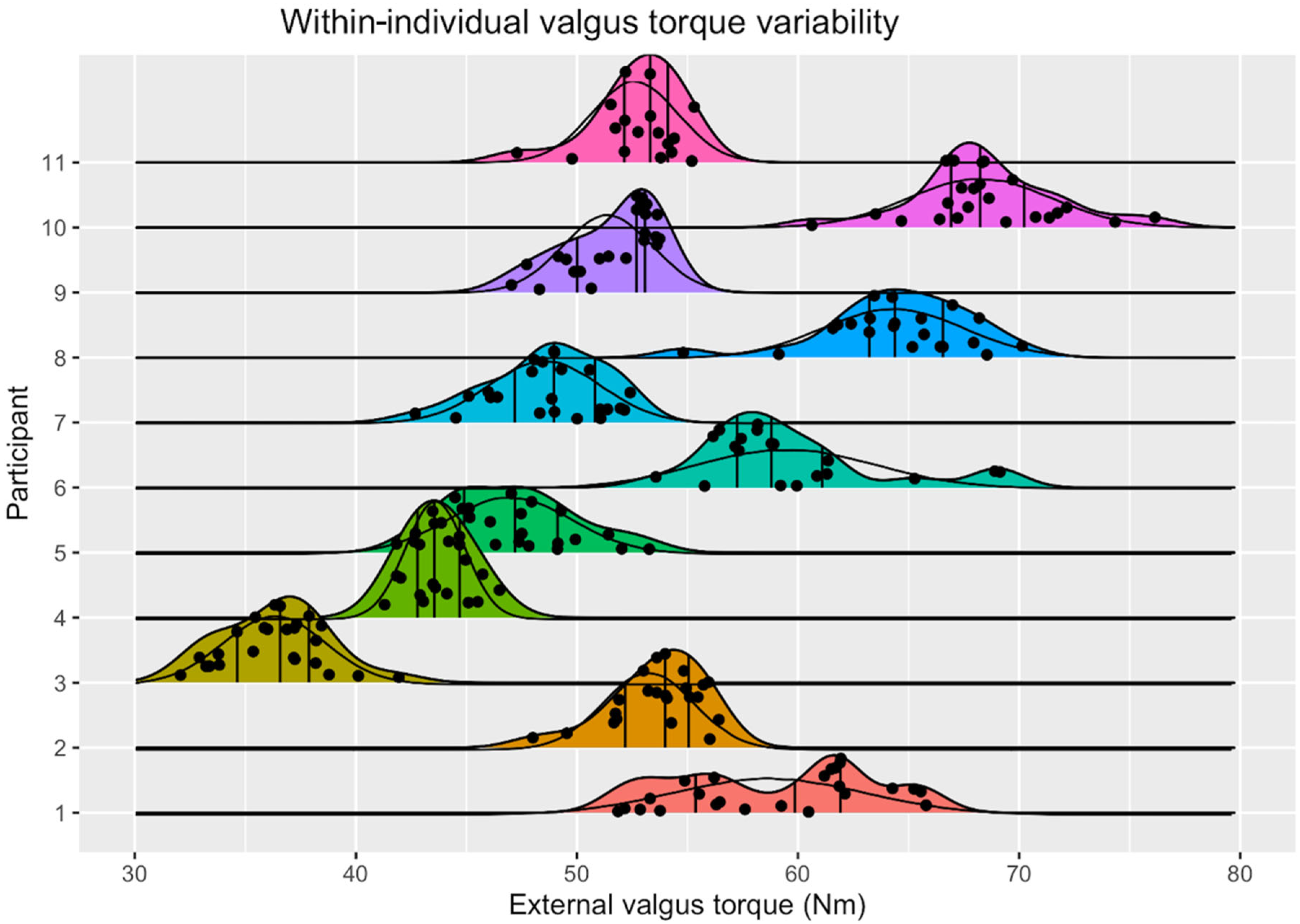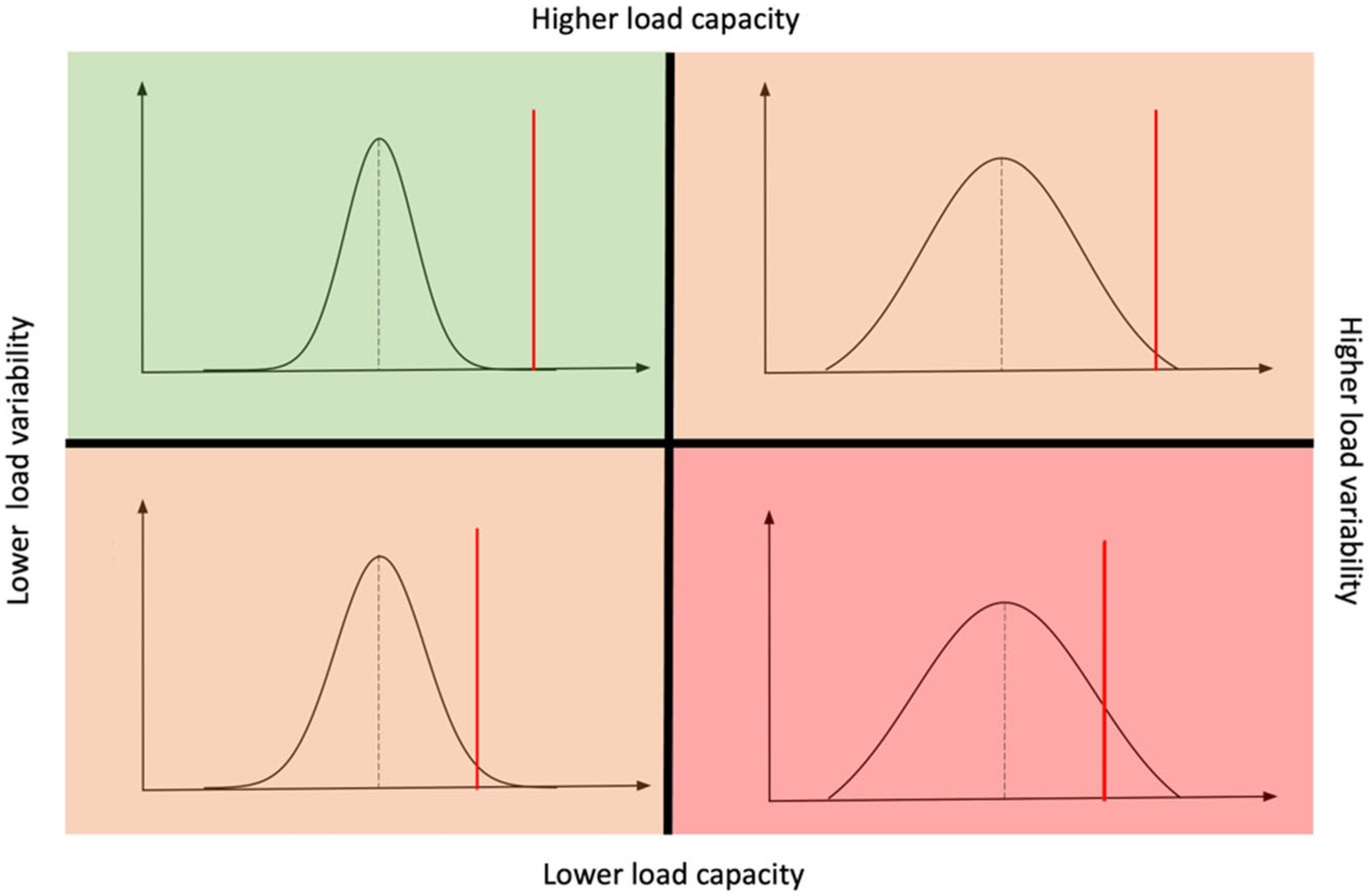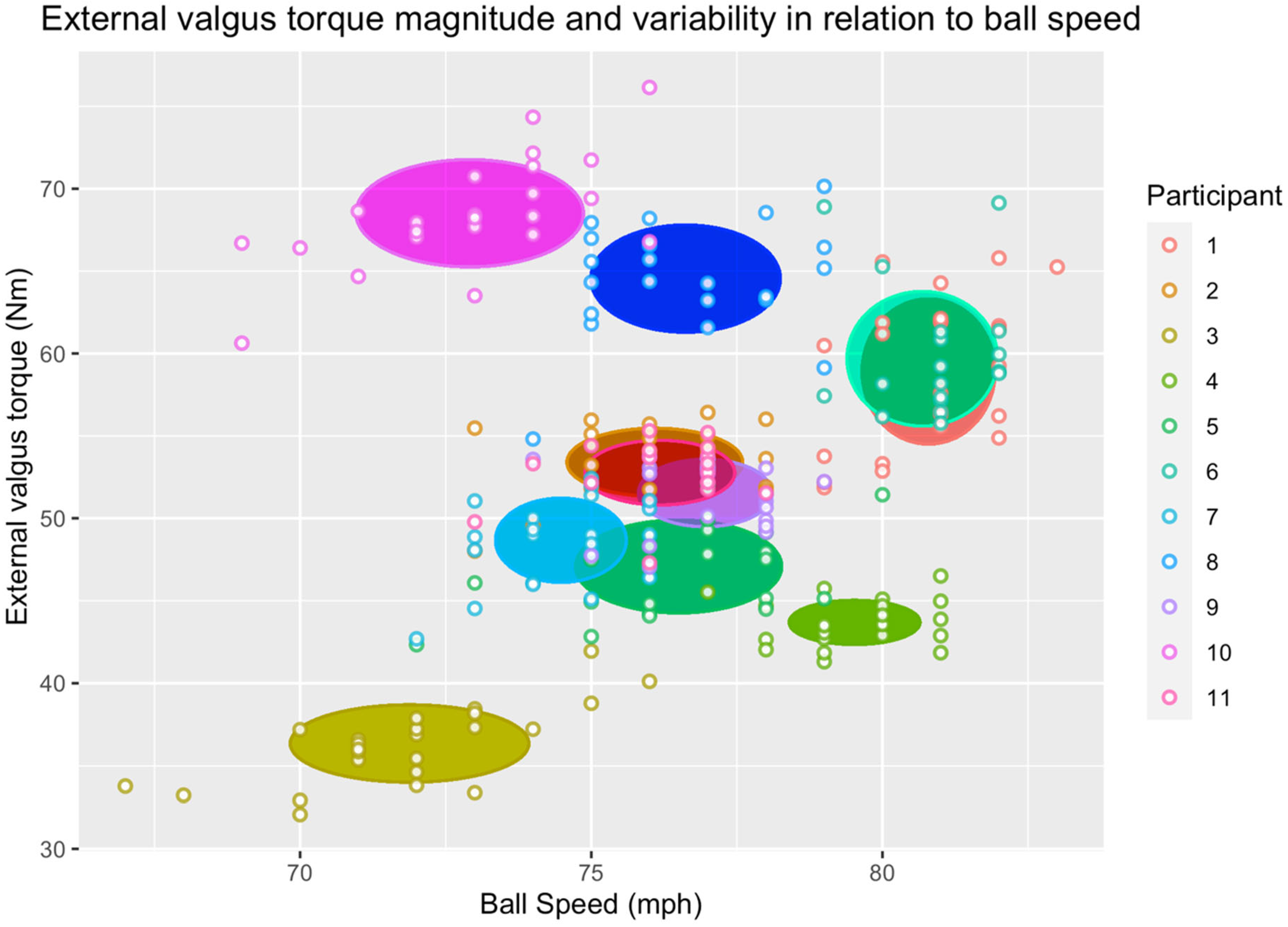1. Introduction
In baseball, faster and more accurate pitches increase the chances of beating the batter and thus winning the game. Professional pitchers can throw a baseball, accurately, at speeds over 100 mph. Fast pitches—often at maximal effort—produce high loads on the body, especially on the throwing arm. The pitchers’ body parts are exposed to these high loads repetitively in practice and competition. The combination of these high loads and the repetitive nature of the pitch motion induces upper extremity injuries [
1]. The most common upper extremity injury is the medial Ulnar Collateral Ligament (UCL) sprain or tear. In Major League Baseball, the highest level of baseball competition in the USA, 25% of the professional pitchers sustain a UCL injury during their career [
2]. In addition, UCL reconstructions—a treatment modality for UCL tears—are reported with a yearly incidence of 4.4% in collegiate pitchers [
3]. The number of UCL reconstructions has increased substantially at all levels of play over recent years [
4]. It is therefore important to prevent athletes from injuries such as UCL injury.
In a systematic review, Bullock et al. [
5] investigated biomechanical factors that are associated with elbow injuries. They concluded that elbow valgus torque and early trunk rotation are positively related to UCL injuries. In addition, in a professional group of pitchers, it was found that maximum ball speed is associated with UCL injuries [
6]. Thus, reducing elbow valgus torque while maintaining ball speed—for example, by the use of a “proper” kinetic chain [
7,
8]—would be the best way of reducing UCL injuries. While the positive association between valgus torque and ball speed at group level is weak, it is considerably stronger on the individual level [
9]. Reducing elbow valgus torque without loss of performance will, however, be complex at the least.
As ball speed and elbow load (i.e., elbow valgus torque) are positively associated with UCL injuries, one could argue that recreational pitchers, who throw slower and with less elbow load, should report fewer UCL injuries compared with professional pitchers. However, this lower level of play also shows a high prevalence of UCL injuries [
3]. In addition, within a homogenous group such as professional baseball pitchers, the average individual level of ball speed or elbow load cannot explain why 25% sustain a UCL injury and others do not, assuming that the individual magnitude is similar in this homogenous group of professionals. Most of the aforementioned studies analyzed a single pitch [
10] or the average of the fastest three–five pitches [
11,
12], neglecting to consider the within-individual variability in ball speed and elbow load. Assuming that reaching a critical (peak) value of valgus torque is a major determinant in UCL injury, this magnitude will depend on the average torque level as well as the within-individual variability of this torque [
13]. Information on both parameters is therefore necessary.
A simple explanatory computational model illustrates that a higher within-individual (elbow) load variability increases (elbow) injury risk [
13]. We modeled the load as a Gaussian distribution with an average, standard deviation, and different numbers of pitches as inputs. In this model, the average and standard deviation are interpreted as the load magnitude and within-individual load variability, respectively. Practice shows that individual pitchers throw baseballs at various speeds. It is, therefore, also likely that the various individual pitches (within for instance a game, practice, or season) are associated with a variation in (peak) elbow load. However, the characteristics of the distributions of the within-individual variability of the elbow load are unknown. If, for instance, it can be established that these distributions of individual variability can be described as Gaussian distributions, individual values of means and standard deviations of elbow load can be used to model each individual pitcher’s risk of suffering an elbow injury.
To date, it is still not possible to measure elbow load, and more specifically, UCL load, during pitching. However, inverse dynamic models can estimate the external valgus torque as the best proxy for UCL load [
5,
14], which can thus be used as a parameter for the study of within-individual variability in elbow load.
Therefore, the aim of this study was to describe the within-individual external valgus torque variability of full effort fastball pitches of elite youth baseball pitchers and determine whether the within-individual external valgus torque variability can be described by a Gaussian distribution.
2. Materials and Methods
2.1. Participants
Data were collected from eleven male Dutch national (AAA) pitchers, at a mean age of 17.4 years (SD 2.2, range 15–23). Mean body mass was 80.6 kg (SD 11.7, range 68.2–107.0), mean body height was 186.7 cm (SD 6.3, range 177.0–194.0), and mean ball speed was 76.6 mph (SD 3.19, range 67–83). These elite youth pitchers are the best pitchers of their age group in the Netherlands. Nine pitchers threw with their right hand, while two pitchers threw with their left. All participants were healthy and experienced no pain, soreness, or range-of-motion restrictions. Before involvement in the study, participants were informed of the procedure and study aims and informed consent forms were signed. This research was conducted in accordance with the Declaration of Helsinki and the local ethics committee of the Faculty of Behavioural and Movement Sciences at the Vrije Universiteit Amsterdam approved the measurement protocol (reference number: VCWE-2019-033).
2.2. Procedure
The measurements were performed at the campus indoor facility of the Royal Dutch Football Association. The pitchers wore sneakers, athletic stretch shorts, catching gloves, and no shirts. Forty-three reflective markers (10 mm diameter) were attached with double-sided tape directly on the skin at bony landmarks. The pitchers were given an unlimited amount of time to perform their warm-up, including running, stretching, and a specific throwing session. Next, they threw several pitches off the mound to become familiar with the research setup. Once the pitchers were ready, they were instructed to throw fastballs as fast and as accurately as possible. The time between each pitch was not controlled but regulated by the pitcher himself, like in a normal game. To investigate the within-individual load variability, the pitchers threw 25 fastballs. The pitchers threw from a pitching mound towards a square strike zone (height 0.64 m; width 0.38 m) 0.55 m above the ground at a regular game distance of 18.44 m.
2.3. Data Acquisition
Marker positions were captured using a Vicon eight-camera motion capture system (model V5; Vicon Motion Systems Ltd., Yarnton, UK) sampled at 400 Hz and stored on a local computer. The ball speed of each pitch was captured from a position next to the strike zone with a radar gun (Stalker Radar, Plano, TX, USA) pointing in the direction of the pitcher.
2.4. Data Analysis
Three-dimensional marker position data were withdrawn in x, y, and z coordinates from the Vicon system, and all the calculations were performed in Python [
15]. All data were analyzed between foot contact and ball release, which includes the critical moment of peak external valgus torque. Foot contact was defined as the moment that the forward velocity of the toe was smaller than 0.3 m/s. Ball release was defined as the moment that the wrist exceeded the position of the elbow in the forward direction. The data were interpolated with a 3rd order cubic spline polynomial and filtered with a 4th order Butterworth filter with a cut-off frequency of 12.5 Hz. If a marker flew off before ball release or if a marker could not correctly be reconstructed, the corresponding pitch was not included. Each trial was visually checked for errors and mistakes. Additionally, participant 11 was not allowed, due to pitching restrictions in his training schedule, to throw more than 20 full-effort pitches. Altogether, 250 of the total 270 pitches performed were used for analysis.
2.5. Inverse Dynamics
For the hand and forearm, an anatomical local coordinate system was made according to the ISB recommendations [
16]. The following bony landmarks on the throwing arm were used: third proximal interphalangeal, ulna processes styloid, radius processes styloid, lateral humeral epicondyle, and medial humeral epicondyle. Positions of the centers of mass and the moments of inertia were estimated according to Zatsiorsky (2002) [
17] and De Leva et al. (1996) [
18]. The baseball was modeled with a mass of 0.145 kg attached to the hand, where the ball mass linearly reduced by 10% over the last ten samples (0.025 s) before ball release. The elbow joint torque was expressed in the anatomical local coordinate system of the elbow, located in the middle of the lateral and medial humeral epicondyle. Using this anatomical coordinate system with the segment data and with the scaling factors of De Leva et al. (1996) and Zatsiorsky et al. (1990), the kinetics of the segments were calculated [
17,
18,
19]. Elbow joint torques were calculated using the top-down inverse dynamic analysis based on the Newton–Euler equation of motions, starting in the hand of the throwing arm. The external elbow valgus torque was calculated as a time series for each single pitch between foot contact and ball release. Subsequently, the peak external valgus torque was obtained from this time series.
2.6. Statistical Analysis
The peak external valgus torque values of the series of pitches of each participant were visually checked for normality with Q–Q plots and tested with the Shapiro–Wilk test. A ridgeline density plot was made for the distribution of the external valgus torque for each participant. The ridgeline density plot included the original data of the external valgus torque. The measures of central tendency and dispersion were calculated. If the data were normally distributed, the standard deviation was used to indicate within-individual elbow valgus torque variability. In addition, a normal distribution was calculated from the external valgus torque mean and standard deviation for each participant and added to the figure with the individual density plots. All statistical analyses were performed in Rstudio (version 2022.2.0.443) [
20].
4. Discussion
The aim of this study was to quantify the within-individual elbow valgus torque variability when pitching fastballs in elite youth baseball pitchers. The results showed that within-individual elbow valgus torque variability is present in pitchers and differed among pitchers. In the majority of these pitchers, the variability can be described as a Gaussian distribution.
Pitching at full effort produces slightly different elbow valgus torques between fastball pitches within a pitcher. As expected, and in line with other studies, the magnitude (average) of the elbow valgus torque was different between pitchers, showing the between-pitcher variability [
8,
11,
21]. The group average elbow valgus torque in this study population was 53.19 Nm (SD 9.34; range: 36.35–68.5). Similar valgus torques were reported in other studies with comparable ball speeds and study population [
8,
11]. In these studies, the valgus torque magnitude differences between pitchers has been regularly reported, but the within-individual valgus torque variability has mostly been neglected. In our study, we show that this within-individual valgus torque variability is present in pitchers and differs between pitchers ranging from 1.34 Nm to 4.40 Nm (
Figure 1). All pitchers were instructed to throw 25 full effort fastballs, and some pitchers were able to throw with less valgus torque variability compared with others. It is known that within-individual variability is smaller compared with between-individual variability [
21]. The magnitude (average) external valgus torque between pitchers can be explained mainly by personal characteristics (body length, mass), motivation, well-being, fatigue, and technique (kinetic chain, energy flow), whereas the within-individual valgus torque variability can mainly be explained by motivation, technique, and fatigue. So, in addition to the magnitude (average) valgus torque, the within-individual valgus torque variability is also different between pitchers.
A higher valgus torque is considered to lead to an increased UCL injury risk, according to previous research [
8,
10,
22]. Within a homogenous group of professional pitchers, 25% sustained a UCL injury [
2]. The valgus torque magnitude on its own cannot completely explain this percentage, as all professional pitchers show high valgus torques. To explain this prevalence, the within-individual load variability and the injury threshold are both important metrics to include [
13]. The injury threshold in this model is the maximal load the UCL can sustain before it strains or tears. The demonstrated within-individual valgus torque variability and the fact that this differs between subjects is a step towards validating the injury model of van Trigt et al. (2020). However, it is suggested that pitchers who throw with a higher magnitude and within-individual variability of valgus torque might have—but do not necessarily have—a higher chance of sustaining an injury, because the injury threshold is also of importance [
13] (
Figure 2). It is important to mention that we did not investigate the relationship between valgus torque variability and injuries.
In the model of van Trigt et al. (2020), a load distribution is formed with a load average and standard deviation. The results showed that the elbow load distribution in nine out of eleven pitchers could be described as a Gaussian distribution. The standard deviation of this Gaussian distribution can be used as a parameter to quantify the within-individual load variability. This study shows that, based on 25 thrown pitches, an individual load distribution can be built with the within-individual load variability and the load magnitude (average), which can be used for injury assessment.
Longitudinal studies have shown that fatigue influences injury risk [
23,
24]. Thus, it is too simplistic to assume that the load magnitude, load variability, and injury threshold are fixed parameters over time and are not influenced by, for example, fatigue. It was found that the development of fatigue over time increases the external valgus torque magnitude [
25], indicating a shift of the load distribution toward the injury threshold. However, it is unknown whether fatigue also influences the within-individual load variability on a micro-level (within a session) or macro-level (between sessions). Executing a study that investigates fatigue in relation to load variability and the effects on an estimated injury threshold based on our model could provide us with new insights.
In terms of practical implications, the presence of within-individual load variability raises the question of whether this load variability is also related to performance. We, therefore, performed a post hoc analysis and analyzed how the pitchers with load variability were distributed in a graph displaying the relationship between ball speed and external valgus torque (
Figure 3). Each dot in
Figure 3 represents a single pitch and each color represents a pitcher, corresponding with the colors in
Figure 1. On a group level, a weak relationship between external valgus torque and ball speed is present. When individual characteristics are included, this results in a much stronger relationship, which is in agreement with the study of Slowik et al. (2019) [
9]. The heights of the ellipses, indicating the within-individual load variability, are randomly scattered in this graph. Linear regression showed that, unlike the valgus torque magnitude, the within-individual valgus torque variability is unrelated to the pitcher average (
p = 0.309, R
2 = 0.1146) or maximal (
p = 0.195, R
2 = 0.1791) ball speed. Thus, based on these preliminary results, it seems that within-individual elbow load variability is not related to performance in this group of pitchers. In practical terms, this means that a pitcher should strive to minimize their elbow load variability as it might reduce the chance of sustaining an injury without influencing performance. It is known that a “proper” technique is related to the elbow valgus torque [
7], and thus it might also be related to the load variability. For injury prevention, it should be investigated whether a pitcher is able to minimize their elbow load variability consciously.
The study population was a homogenous group of youth elite baseball pitchers (age 15–22). It is known that the magnitude of external elbow valgus torque increases with the level of play [
11]. The group average valgus torque variability did not show significant differences between levels of play according to Fleisig et al. (2009) [
26], indicating that our results showing differences between pitchers in within-individual load variability can be extended to other levels of play. A large difference between our study and the study of Fleisig et al. (2009) is that they only included the 5 fastest pitches in their analysis to describe within-individual variability, which is less compared to the 25 analyzed pitches in our study. Five pitches are too few to define whether the valgus torque is normally distributed. Therefore, it is unclear whether the finding that a load distribution can be described with a Gaussian distribution can be extended to other levels of play.
A limitation of this study is that the external valgus torque magnitude and variability are assumed to be representative of the magnitude and variability of the UCL load. The literature shows that, in addition to the UCL, elbow muscles and joint articulation can also counteract the external valgus torque [
27]. How the magnitude and variability of the valgus torque load are distributed over these anatomical structures is yet unknown. Thus, how much of the valgus torque magnitude and variability can be translated to the UCL load and variability should be investigated in the future. In conclusion, as it is known that the external valgus torque is related to UCL load and UCL injuries [
8,
14], we conclude that UCL load variability is present within baseball pitchers. However, the exact values of magnitude and variability depend on other elbow stabilizers and the individual pitcher.










_Veeger.png)

